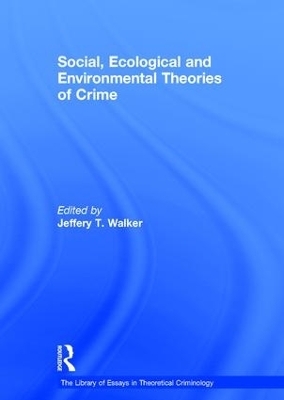
Social, Ecological and Environmental Theories of Crime
Routledge (Verlag)
978-0-7546-2897-2 (ISBN)
One of the oldest and most extensive forms of criminology falls within what is referred to, among other names, as social ecology. Beginning with the work of Guerry and Quetelet, this theory became the dominate paradigm in explaining crime with the work of the Chicago School in the early 1900s, social disorganization theory, and neighborhood research attempting to deal with crime in deteriorating cities. Social ecology is also the basis for the research being conducted in environmental criminology. This volume offers a selection of the most influential works in social ecology and environmental criminology. It begins with research from human ecology and the Chicago School, extending through some of the research in social disorganization theory. It encompasses some of the major journal articles from the 1980s and 1990s in neighborhoods and crime, and then addresses some of the quintessential works in environmental criminology. It ends with groundbreaking work in this area that may indicate the future direction of the field. This valuable collection includes an excellent introduction by Jeff Walker.
Jeffery T. Walker is Professor of Criminal Justice and Criminology at the University of Arkansas, Little Rock, USA
Contents: Introduction; Part I The Early Days - Human Ecology: The study of the delinquent as a person, Ernest W. Burgess; The ecological approach to the study of the human community, R. D. McKenzie; Human ecology, Robert Ezra Park; Ecology and human ecology, Amos H. Hawley. Part II Social Disorganization and Beyond: The neighborhood and child conduct, Henry D. McKay; Rejoinder, Clifford R. Shaw; The conflict of values in delinquency areas, Solomon Kobrin; Community structure and crime: testing social-disorganization theory, Robert J. Sampson and W. Byron Groves. Part III The Focus on Deteriorating Neighbourhoods: Dangerous places: crime and residential environment, Dennis W. Roncek; Community change and patterns of delinquency, Robert J. Bursik Jr and Jim Webb; The police and neighborhood safety: broken windows, James Q. Wilson and George L. Kelling; Neighborhood and delinquency: an assessment of contextual effects, Ora Simcha-Fagan and Joseph E. Schwartz; Neighborhood social capital as differential social organization: resident and leadership dimensions, Robert J. Sampson and Corina Graif . Part IV The Rise of Environmental Criminology: Crime prevention and control through environmental engineering, C. Ray Jeffery; The spatial patterning of burglary, Paul J. Brantingham and Patricia L. Brantingham; Some effects of being female on criminal spatial behavior, George F. Rengert; Crime seen through a cone of resolution, Paul J. Brantingham, Delmar A. Dyreson and Patricia L. Brantingham; Cities and crime: a geographic model, Keith D. Harries; The effects of building size on personal crime and fear of crime, Oscar Newman and Karen A. Franck; The methods and measures of centrography and the spatial dynamics of rape, James L. LeBeau; Nodes, paths and edges: considerations on the complexity of crime and the physical environment, Patricia L. Brantingham and Paul J. Brantingham. Part V Recent Works in Social, Ecological and Environmental Criminology: Crime measures and the
| Erscheint lt. Verlag | 15.4.2011 |
|---|---|
| Reihe/Serie | The Library of Essays in Theoretical Criminology |
| Verlagsort | London |
| Sprache | englisch |
| Maße | 169 x 244 mm |
| Gewicht | 1292 g |
| Themenwelt | Recht / Steuern ► Allgemeines / Lexika |
| Recht / Steuern ► Arbeits- / Sozialrecht ► Sozialrecht | |
| Recht / Steuern ► EU / Internationales Recht | |
| Recht / Steuern ► Strafrecht ► Kriminologie | |
| Sozialwissenschaften | |
| ISBN-10 | 0-7546-2897-3 / 0754628973 |
| ISBN-13 | 978-0-7546-2897-2 / 9780754628972 |
| Zustand | Neuware |
| Haben Sie eine Frage zum Produkt? |
aus dem Bereich


